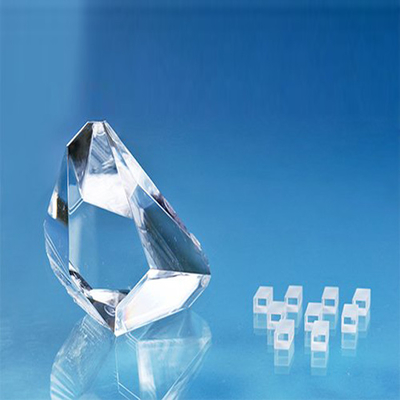-
Optical Quartz Glass
-
Machining Quartz Glass
-
Quartz Glass Tube
-
Quartz Capillary Tube
-
Borosilicate Glass Tube
-
Quartz Glass Rod
-
Laser Spare Parts
-
Silicon Dioxide Sputtering Target
-
Quartz Apparatus
-
Quartz Glass Plate
-
Custom Glass Parts
-
Custom Ceramic Parts
-
Optical Manufacturing Equipment
-
Mobile Glass Cover Making Machine
-
Optical Measuring Instrument
-
Optical Crystal
Lbo Lithium Triborate Crystal Lib3o5 Frequency Doubling

Contact me for free samples and coupons.
Whatsapp:0086 18588475571
Wechat: 0086 18588475571
Skype: sales10@aixton.com
If you have any concern, we provide 24-hour online help.
x| Chemical Formula | LiB3O5 | Crystal Structure | Orthorhombic, Mm2 |
|---|---|---|---|
| Cell Parameters | A = 8.4473, B = 7.3788Å, C = 5.1395Å, Z = 2 | Melting Point | 834°C |
| Optical Homogeneity | Dn ~ 10-6/cm | Mohs Hardness | 6 |
| Density | 2.47g/cm3 | Specific Heat | 1.91J/cm3xK |
| Hygroscopic Susceptibility | Low | Thermal Expansion Coefficients | A, 4 X 10-6/K; C, 36 X 10-6/K |
| Highlight | frequency doubling lithium triborate crystal,lib3o5 lithium triborate crystal,lib3o5 lbo crystal |
||
LBO Lithium Triborate Crystal
LBO crystal is an excellent frequency doubling crystal, which is a widely used frequency doubling device at present. Its internal optical uniformity is good, the transmission band is relatively wide, and it has high matching efficiency and laser damage threshold.
Application
1. Double frequency
(1) Nd: YAG lasers for medical and industrial purposes;
(2) High power Nd: YAG and Nd: YLF lasers for scientific research and military purposes
(3) Pumping of Nd: YVO4, Nd: YAG, and Nd: YLF lasers
(4) Ruby, titanium sapphire, and Cr: LiSAF laser;
2. Triple frequency
(1) Nd: YAG and Nd: YLF lasers
(2) Optical parametric amplifier (OPA) and optical parametric oscillator (OPO)
(3) Second and third harmonic generation of high-power 1340nm Nd: YAP laser
Main properties:
| Chemical Formula | LiB3O5 |
| Crystal Structure | Orthorhombic, mm2 |
| Cell Parameters | a = 8.4473, b = 7.3788Å, c = 5.1395Å, Z = 2 |
| Melting point | 834°C |
| Optical homogeneity | dn ~ 10-6/cm |
| Mohs hardness | 6 |
| Density | 2.47g/cm3 |
| Absorption coefficient | < 0.1%/cm (at 1064nm and 532nm) |
| Specific heat | 1.91J/cm3xK |
| Hygroscopic susceptibility | low |
| Thermal expansion coefficients | a, 4 x 10-6/K; c, 36 x 10-6/K |
| Thermal conductivity | ^ c, 1.2 W/m/K; //c, 1.6 W/m/K |
Linear optical characteristics
| Transparency range | 1 60-2600nm |
| Refractive indices: at 1064nm at 532nm at 355nm |
nx = 1.5656, ny = 1.5905, nz = 1.6055 ne = 1.5785, no = 1.6065, nz = 1.6212 ne = 1.5971, no = 1.6275, nz = 1.6430 |
| Therm-optic coefficients | dno/dT = -9.3 x 10-6/°C dne/dT = -16.6 x 10-6/°C |
| Sellmeier Equations (l in mm) | |
| no2 (l) = 2.7359 – 0.01354l2+ 0.01878/(l2-0.01822) ne2(l) = 2.3753 – 0.01516l2+ 0.01224/(l2-0.01667) |
|
Non-linear optical characteristics
| Phase-matchable output wavelength | 554 – 30%0nm (type I), 790 – 2150nm (type II) |
| NLO coefficients | d33 = 0.06; d32 = 1.2; d22 = 1.1 |
| Walk-off Angles(@ 1064nm) | 0.4° (Type I SHG), 0.3° (Type II SHG) |
| Acceptance Angles(@1064nm) for SHG Type I | 9.6(mrad-cm) CPM at 25°C 248(mrad-cm) NCPM at 150°C |
| Electro-optic coefficients | g 11 = 2.7 pm/V, g 22, g31 < 0.1g11 |
| Conversion Efficiency | >90% (1064 -> 532nm) Type I SHG |
| Damage threshold at 1064nm at 532nm at 355nm |
45 GW/cm2 (1 ns); 10 GW/cm2 (1.3 ns) 26 GW/cm2 (1 ns); 7 GW/cm2 (250 ps) 22 GW/cm2 |




